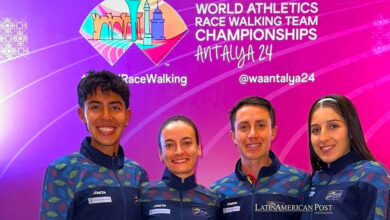VAR: What does it need to be applied in all Latin American soccer leagues?
Listen this article
Although some championships have already done tests with video assistant referees, its use in the region has not been extended nor has a deadline been established

It was a difficult process to get FIFA to accept the possibility of integrating the Video Assistant Referee, also known as VAR, into world football. Since 2016, it has been tested in every kind of competition: Club World Cup, leagues, Confederations Cup, World Cup, Copa Libertadores, among other tournaments. Russia 2018 was a high point for its establishment. Despite the controversy that arose in some games, FIFA considered that it had been a success. Infantino assured that the accuracy of the referees had been almost perfect, informed the newspaper Marca. However, its use throughout the world is moving slowly and with much uncertainty.
Leer en español: VAR:¿qué falta para que se aplique en todas las ligas de Latinoamérica?
Latin America
Although the International Football Association Board (IFAB) and FIFA gave their approval to the VAR, its integration into the world of football has not been easy. In some cases it is about distrust, as in the English Premier League; in others, it is the high cost of technology, which is the case in most of Latin America. In this continent, the first league that used the VAR officially was the Major League Soccer (MLS) of the United States, which, according to Marca, uses it since 2017. Even so, considering only Latin America, only the Liga MX uses video referee technology, and with great controversy, from day 13 of the Apertura 2018, according to information from ESPN.
No other league in the region uses it completely: only tests have been done in Argentina, Brazil, Colombia and Chile, and the test that Conmebol did in the final phase of the Libertadores and the Sudamericana in 2017, according to Tele13. This journal also reports that Chile has already launched the bidding process to install it, and for the winning company to be in charge of administering the technology during 2020 and 2021, in addition to training the arbitrators. Peru is planning to release it in the 1-2019 League, while in Colombia it has been postponed since December, says Marca.
Argentina intends to start using for the second semester of 2019. In this regard, the president of the Superliga, Mariano Elizondo, told Clarin: "So that the video arbitration system can be applied in all the matches of the First Division of Argentine soccer, at least one year will be needed. So for the next edition of the Superliga it will not be possible, we could only expect the VAR in the 2019/2020 season of the local tournament. It involves not only the technological aspect, but also the training of those who will manage the system."
Copa América 2020: more questions than answers
The costs of VAR
According to La Nación of Costa Rica, there are two ways to implement the VAR:
- Through mobile units that contain the control room of the referees, that is, from where they handle the images that arrive at the unit. Therefore, they do not have their own cameras and they depend on the television stations for their use. It would require that the television stations have a minimum number of cameras in the stadium to operate because the stations do not manipulate the images; they send them directly to the unit that is the one that evaluates them.
- The second option is through a central office, where the images of all the stadiums arrive by optical fiber, which was the technology applied in Russia 2018. This system is more efficient, but it depends entirely on the development of communications in each country.
In the case of Liga MX, its system is through mobile units that are connected in each stadium. For the other cases left in Latin America it seems that it will be the same option. Clarín reports that for the Superliga the VAR in each match would cost about $ 8,000 dollars, a total of $ 2.7 million dollars per season. The Argentinians seek to resolve it through the sponsorship of some company.
In Costa Rica, La Nación assures that VAR is not affordable, especially when the league has major deficiencies such as lighting or the development of basic forces. In the same situation is the majority of Central and South America, because the cost is not only the technology, but also the training of the referees, their fees per season and the certification that the system must obtain from the IFAB.
LatinAmerican Post | Luis Ángel Hernández Liborio
Translated from "VAR:¿qué falta para que se aplique en todas las ligas de Latinoamérica?"




